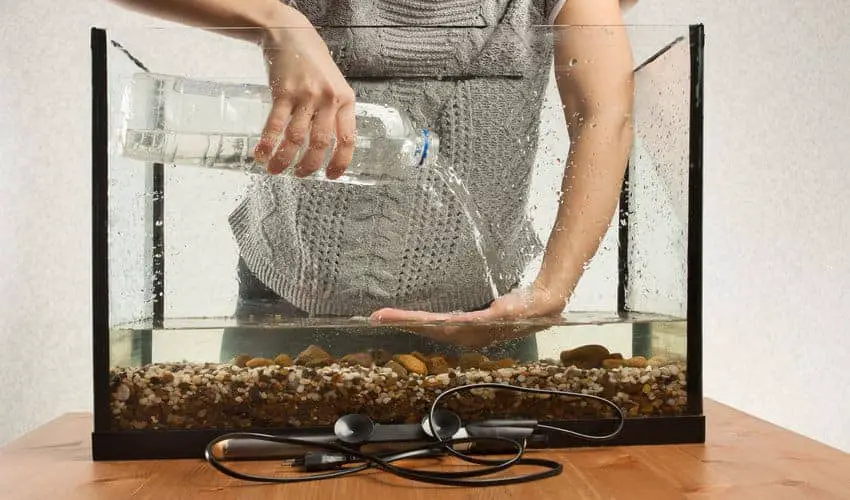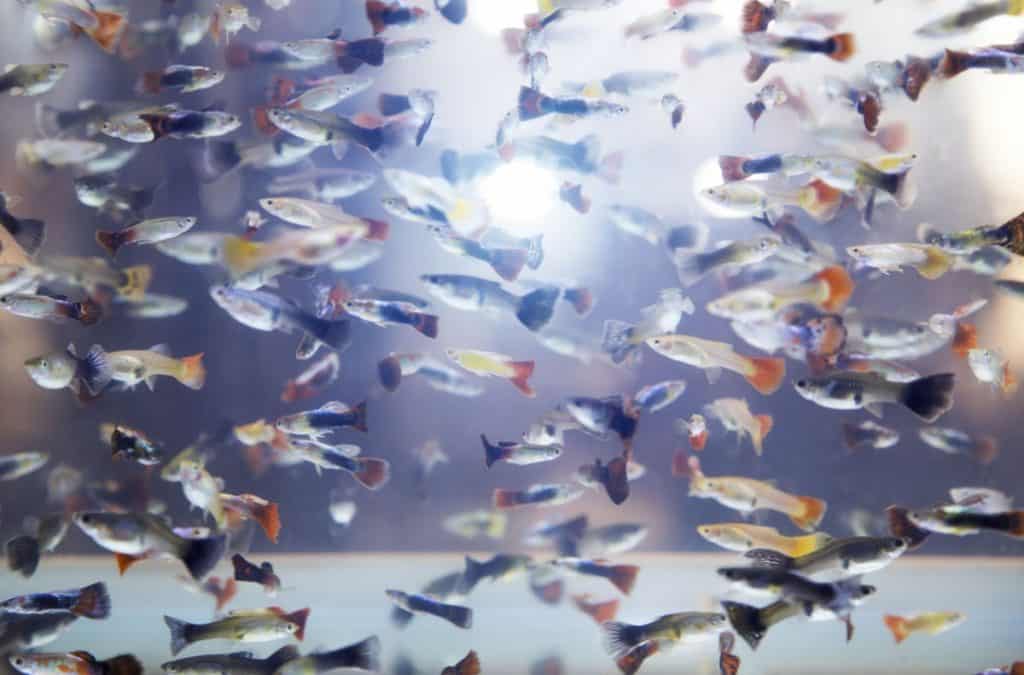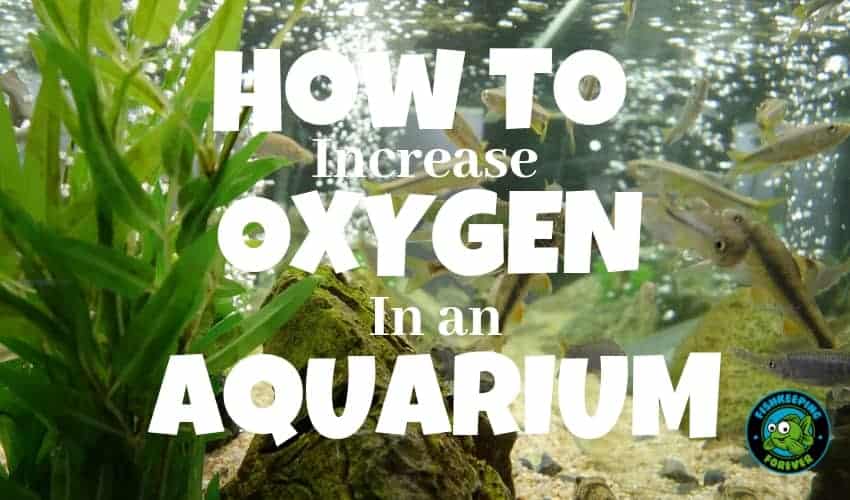When it comes to aquariums, oxygen is one of those things that we know we need, but tend to forget about because we can’t see it. That is until there isn’t enough oxygen in our tanks and then we think about it a lot whilst trying to source ways to increase it.
Before we can even consider increasing the oxygen levels in our aquariums, we need to understand where our fish get their oxygen from. Believe me, when I say, it is not from where you would think!
How to increase oxygen in a fish tank? The best way to increase oxygen is to increase the surface area of the aquarium. Increase Surface agitation or water movement on the surface. This allows more oxygen to dissolve and more carbon dioxide to escape. You can also add a source of fresh oxygen by installing an air pump.

Table of Contents
Where Do Fish Get Oxygen To Breathe From?
The oxygen that your fish breathe is not sourced directly from their water, but rather from the surrounding air. This may sound crazy since water contains oxygen already, but it’s really not.
The hydrogen and the oxygen that make up water are inseparable meaning your fish cannot extract the oxygen to breathe it.
Rather, fish obtain their oxygen from the surface of the water where a process is known as a ‘gas exchange’ takes place. It is known as an exchange because the air and water do a trade swapping CO2 (carbon dioxide) from the water and O2 (oxygen) from the air.
This is a useful and continuous trade since fish breathe in oxygen and give off carbon dioxide.

How To Increase Oxygen In a Fish Tank?
Now we know that the oxygen your fish breathe is introduced into their aquarium, rather than already being present, we can address ways to increase it. There are a number of these, some more obvious than others, but all ones that will help you in your pursuit of more oxygen.
Increasing Aquarium Surface Area – The gas exchange that takes place in order to introduce breathable oxygen into your tank is done on the surface of the water.
This means that the larger the surface area is on your tank, the more oxygen there will be introduced. You should bear this in mind when choosing both aquarium size (water capacity) and aquarium shape (rectangle, cube, bowl) to achieve maximum potential gas exchange.
Increasing Surface Agitation – Surface agitation, or water movement on the surface, increases the surface area. This allows more oxygen to dissolve and more carbon dioxide to escape.
Surface agitation can be achieved in many ways including with:
- Aquarium bubblers that attach to an air pump via an airline. These come in many shapes and sizes such as air stones which can be placed underneath the gravel, or attached to ornaments such as treasure chests which are pushed open by the pressure releasing streams of bubbles/oxygen.
- HOB filters which by definition hang on the back of your aquarium releasing filtered water back into the aquarium at the surface. This releasing of water moves the surface creating as previously stated more surface area for gas exchange to take place.
- Powerheads which are used throughout aquariums to create more water flow.
- Wavemakers that create waves that are similar to the seas and oceans. They do this by creating a water surge that agitates the surface.
- Spray bars which sprinkle water gently back into the aquarium from your filter outlet. They do the same job as the water outlet on HOB filters but are made to be used with external filters.

Stocking Your Tank Correctly – This may sound like a strange way to increase the levels of oxygen in your aquarium but it makes perfect sense when you think about it.
After all, every fish you add to your tank needs oxygen to breathe meaning more fish = more oxygen needed. Overstocked tanks cannot support the oxygen needs of all their inhabitants.
Caring For Your Plants – We are always hearing in the fish keeping hobby how plants are excellent for aquariums as they use carbon dioxide and give off oxygen. However, what we don’t hear, is that this is only true if plants are given access to the proper lighting.
Plants, believe it or not, consume oxygen and give off CO2 during the night meaning that extended periods of darkness could deplete your fishes oxygen supply.
However, plants are one of the best ways to naturally increase oxygen into a home aquarium.
Controlling Temperature Rises – Believe it or not, cool water holds more oxygen than warm water does. This means that any rise in aquarium temperatures could lead to less oxygen in your tanks.
To avoid this, you should shade your tanks from direct sunlight, especially on hot days, and consider turning off your aquarium heating as well. If the temperature changes more than a few degrees fans can be used to also lower the aquarium temperature to a more acceptable level.
Taking Care With Chemicals And Medications – Certain medications and chemicals, for example, water conditioners, can have a direct effect on the oxygen-carrying ability of the water in your aquarium.
Always read the labels on these products and follow instructions on dose size to ensure that you do not adversely affect your water.

Fish tank emergency
In the event of an emergency, such as your fish are all at the surface gasping for air, the above measures to increase oxygen in your tank will not be sufficient to save your fish.
Rather, you should perform a large water change, up to 50% immediately. This, the adding of new water, will bring in enough dissolved oxygen that your fish will be OK in the short term. You should, however, once the emergency is over source the root cause of the lack of oxygen and address it.
Too Much Oxygen In A Fish Tank
It would be remiss not to mention that you can over oxygenate an aquarium and that too much oxygen in a fish tank can be bad. So bad, in fact, that it leads to lethal gas bubble disease.
This is where the fish breathes in over-oxygenated water and it leaches out of their bloodstream creating bubbles in their body tissue. It is then visible in the form of bubbles on the gills, eyes, and fins of your fish. Invisibly, it can also build up in the fish’s heart and lead to death.
Conclusion: How to increase oxygen in a fish tank
Over oxygenation happens because water can only hold so much oxygen before it becomes saturated. Once saturated, no more oxygen can be dissolved. Fish will happily, and harmlessly, breath in water that is saturated without any problems.
Problems do arise, however, when the water fish are breathing in becomes supersaturated. This occurrence is not common, but it does happen and is the root cause of gas bubble disease.
If you want to be sure you avoid this disease, simply use a quick, easy, and readily available, from most local fish stores, dissolved oxygen test kit.
The truth is, however, that you don’t really need to be testing your water for oxygen levels unless you think there is a problem.
Having low oxygen levels can be just as devastating to your fish. Read what signs to look out for and how to correct it quickly before you harm your fish.
There is a much simpler way to ensure your fish get all the oxygen that they need and not too much. Simply follow the guidelines above and use one or two of our oxygen increasing suggestions and you soon have a happily and healthily breathing tank full of fish.
- Silver Arowana: Complete, Care, Breeding, Feeding Guide
- Rainbow Shark: Diet | Size | Breeding | Cost
- Tiger Barb Fish: Diet | Breeding | Size | Water Conditions
- Jack Dempsey: Diet | Size | Breeding | Lifespan | Sexing | Care Guide
- How Are GloFish Made? Facts & F.A.Q

I have been working in the tropical fish industry for over 30 years now and I’m still learning. Everyday is a school day in this hobby. In my spare time I play golf very badly!




